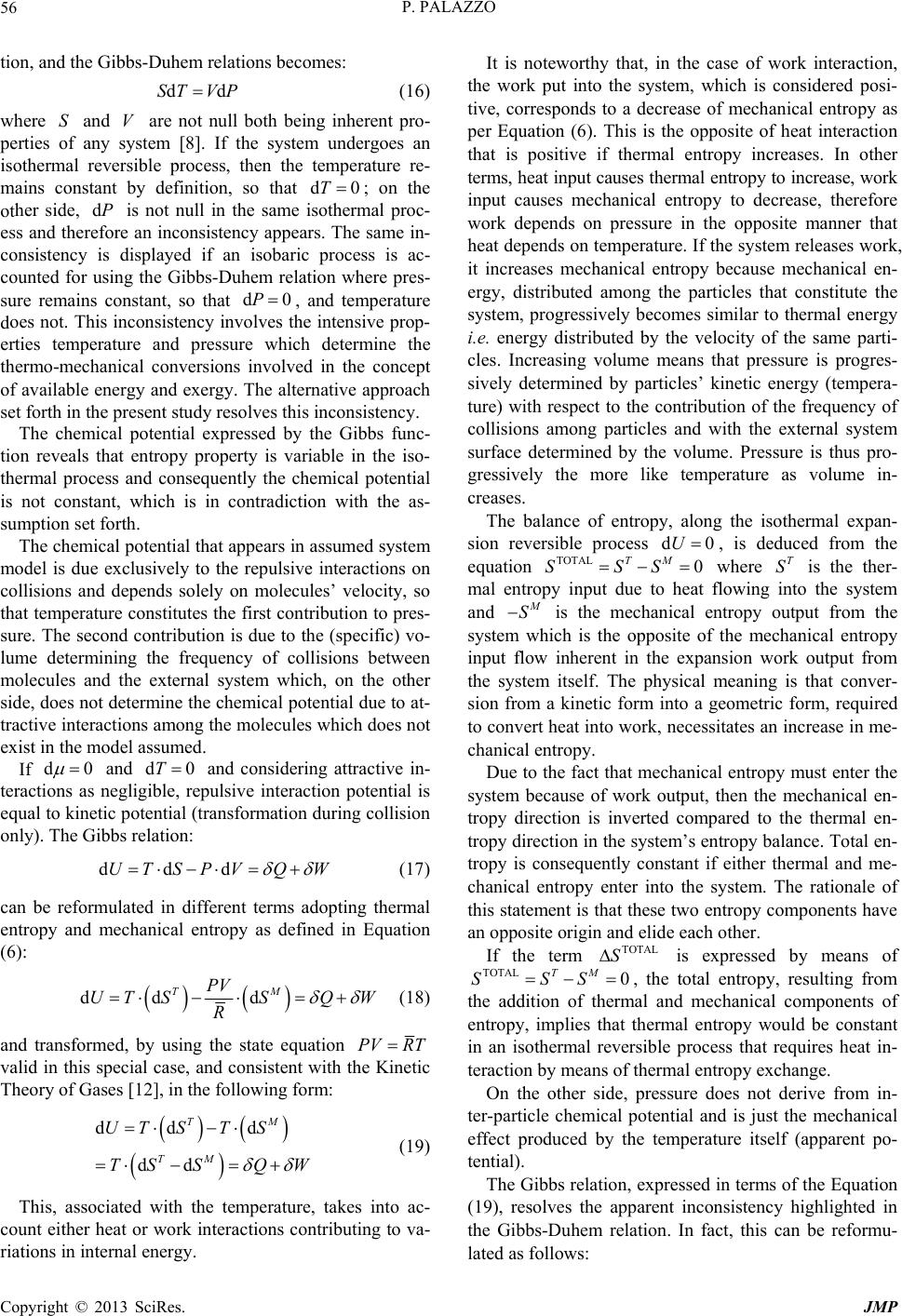
P. PALAZZO
56
tion, and the Gibbs-Duhem relations becomes:
ddST VP
S
d0T
dP
d0
0
(16)
where and V are not null both being inherent pro-
perties of any system [8]. If the system undergoes an
isothermal reversible process, then the temperature re-
mains constant by definition, so that ; on the
other side, is not null in the same isothermal proc-
ess and therefore an inconsistency appears. The same in-
consistency is displayed if an isobaric process is ac-
counted for using the Gibbs-Duhem relation where pres-
sure remains constant, so that , and temperature
does not. This inconsistency involves the intensive prop-
erties temperature and pressure which determine the
thermo-mechanical conversions involved in the concept
of available energy and exergy. The alternative ap proach
set forth in the present study resolves this inco nsistency.
P
The chemical potential expressed by the Gibbs func-
tion reveals that entropy property is variable in the iso-
thermal process and consequently the chemical potential
is not constant, which is in contradiction with the as-
sumption set forth.
The chemical potential that appears in assumed system
model is due exclusively to the repulsive interactions on
collisions and depends solely on molecules’ velocity, so
that temperature constitutes the first contribution to pres-
sure. The second contribution is due to the (specific) vo-
lume determining the frequency of collisions between
molecules and the external system which, on the other
side, does not determine the chemical potential due to at-
tractive interactions among the molecules which does not
exist in the model assumed.
If d
and and considering attractive in-
teractions as negligible, repulsive interaction potential is
equal to kinetic poten tial (transformation during collision
only). The Gibbs rel at i on:
d0T
dVQ WddUTSP
(17)
can be reformulated in different terms adopting thermal
entropy and mechanical entropy as defined in Equation
(6):
dQ Wdd
TM
PV
UT SS
R
(18)
and transformed, by using the state equation PV RT
d
TM
T S
QW
valid in this special case, and consistent with the Kinetic
Theory of Gases [12], in the following form:
dd
dd
TM
UTS
TSS
0U
TOTAL 0
TM
SSS
(19)
This, associated with the temperature, takes into ac-
count either heat or work interactions contributing to va-
riations in internal energy.
It is noteworthy that, in the case of work interaction,
the work put into the system, which is considered posi-
tive, corresponds to a decrease of mechanical entropy as
per Equation (6). This is the opposite of heat interaction
that is positive if thermal entropy increases. In other
terms, heat inpu t causes thermal entropy to increas e, work
input causes mechanical entropy to decrease, therefore
work depends on pressure in the opposite manner that
heat depends on temperature. If the system releases work,
it increases mechanical entropy because mechanical en-
ergy, distributed among the particles that constitute the
system, progressively becomes similar to thermal energy
i.e. energy distributed by the velocity of the same parti-
cles. Increasing volume means that pressure is progres-
sively determined by particles’ kinetic energy (tempera-
ture) with respect to the contribution of the frequency of
collisions among particles and with the external system
surface determined by the volume. Pressure is thus pro-
gressively the more like temperature as volume in-
creases.
The balance of entropy, along the isothermal expan-
sion reversible process d, is deduced from the
equation
T
S where is the ther-
mal entropy input due to heat flowing into the system
and
S
TOTAL
S
TOTAL 0
TM
SSS
is the mechanical entropy output from the
system which is the opposite of the mechanical entropy
input flow inherent in the expansion work output from
the system itself. The physical meaning is that conver-
sion from a kinetic form into a geometric form, required
to convert heat into work, necessitates an increase in me-
chanical entropy.
Due to the fact that mechanical entropy must enter the
system because of work output, then the mechanical en-
tropy direction is inverted compared to the thermal en-
tropy direction in the system’s entropy balance. Total en-
tropy is consequently constant if either thermal and me-
chanical entropy enter into the system. The rationale of
this statement is that these two entrop y components have
an opposite origin and elide each other.
If the term is expressed by means of
, the total entropy, resulting from
the addition of thermal and mechanical components of
entropy, implies that thermal entropy would be constant
in an isothermal reversible process that requires heat in-
teraction by means of thermal entropy exchange.
On the other side, pressure does not derive from in-
ter-particle chemical potential and is just the mechanical
effect produced by the temperature itself (apparent po-
tential).
The Gibbs relation, expressed in terms of the Equation
(19), resolves the apparent inconsistency highlighted in
the Gibbs-Duhem relation. In fact, this can be reformu-
lated as follows:
Copyright © 2013 SciRes. JMP